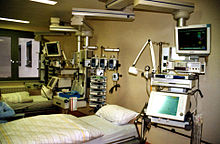Apparatus medicine
Apparatus medicine or device medicine is a term for the technology-oriented work carried out by people in medical professions, which is dominated by modern devices and neglects the subjective concerns of the patient. Depending on the context, large devices such as magnetic resonance tomographs or linear accelerators can be used, the complex technical equipment of intensive care units , or the entirety of the aids that medical technology , biomedicine , medical informatics , medical physics , biophysics , biotechnology , genetic engineering , and the engineering sciences for patient care and Have contributed to preventive healthcare . Apparatus medicine and its costs are often the subject of social debates; The population's interest in apparatus medicine is estimated to be very high.
Technical apparatus such as X-ray machines expand the physicians' ability to perceive and act; they allow diagnoses and treatments with high accuracy; At the same time, their availability has a strong influence on the organization and degree of standardization of medical processes. Like everyday technology, medical devices help determine the environment in which they are created; For example, the further development of surgical and anesthesiological technology has resulted in a sub-specialization of the interacting experts in the operating room, which seemed unthinkable just a few decades ago. These mutual expansions, restrictions and dependencies between people and technology are a research area of sociological technology research .
The term apparatus medicine is often used to express criticism of medicine that is perceived as being too technology-oriented and remote from the patient , for example in the discussion of costs in the health care system , in the context of euthanasia or in statements on fertilization medicine . In this context, apparatus medicine is often contrasted with so-called speaking medicine , which emphasizes personal doctor-patient contact as an expression of human affection. It is also about financial distribution struggles among medical service providers.
See also
literature
- Susanne Hahn: Apparatus Medicine. In: Werner E. Gerabek , Bernhard D. Haage, Gundolf Keil , Wolfgang Wegner (eds.): Enzyklopädie Medizingeschichte. De Gruyter, Berlin / New York 2005, ISBN 3-11-015714-4 , p. 86 f.
Sources and individual references
- ^ Rüdiger Kramme: Medical technology: procedures, systems, information processing . Springer, November 27, 2006, ISBN 978-3-540-34102-4 , pp. 7– (accessed on August 18, 2011).
- ↑ Apparatus medicine: More clarification and information material desired. Dtsch Arztebl 108 (8): A-400 / B-324 / C-324 February 25, 2011
- ↑ Werner Vogd: Modern myths of medicine: Studies on organized sick treatment . VS Verlag, 2008, ISBN 978-3-531-15425-1 , pp. 139– (accessed on August 18, 2011).
- ↑ Cornelius Schubert: The practice of apparatus medicine: Doctors and technology in the operating theater . Campus Verlag, September 2006, ISBN 978-3-593-38188-6 (accessed August 18, 2011).
- ↑ Klaus-Michael Kodalle: The right to die in dignity: a current challenge from a historical and systematic perspective . Königshausen & Neumann, January 2003, ISBN 978-3-8260-2489-4 , pp. 54– (accessed on August 18, 2011).
- ↑ Barbara Böckenförde-Wunderlich: Preimplantation diagnostics as a legal problem: medical professional law, embryo protection law, constitution . Mohr Siebeck, December 1, 2002, ISBN 978-3-16-147924-3 , pp. 175– (accessed on August 18, 2011).
- ↑ The speaking medicine. Die Welt online, June 29, 2000
- ↑ EU Charter of Patients' Rights: Blind Spot. Niedersächsisches Zahnärzteblatt 6/2011, pp. 4–7 PDF
- ↑ When the benefices shrink. Friday online March 19, 2009

